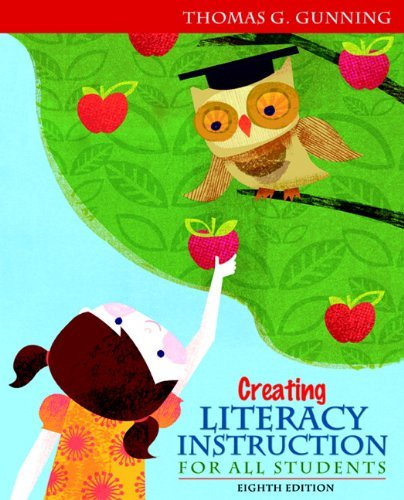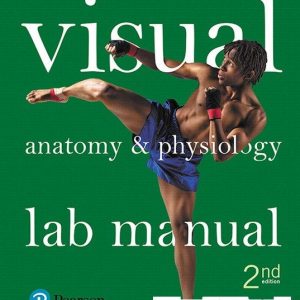Creating Literacy Instruction for All Students Gunning 8th Edition Test Bank

Product details:
- ISBN-10 : 0132685795
- ISBN-13 : 978-0132685795
- Author: Thomas G. Gunning
Description:
Chapter 1 The Nature of Literacy
1.1 Multiple Choice Questions
1) Which of the following is an example of a behavioral approach?
- A) providing students with hands-on activities in which they assemble a toy to show that they have comprehended a set of directions
- B) making sure that students can answer 80 percent of the comprehension questions before moving to the next level
- C) having students work in pairs so they can learn from each other
- D) making sure that students are in the zone of proximal development
Answer: B / Explanation:
- A) In a behavioral approach, students demonstrate mastery of one skill level before moving to the next level. This approach tends to be teacher oriented. Hands-on activities and having students work in pairs could be used with any approach. Making sure students are in the zone of proximal development tends to be used with cognitive approaches.
- B) In a behavioral approach, students demonstrate mastery of one skill level before moving to the next level. This approach tends to be teacher oriented. Hands-on activities and having students work in pairs could be used with any approach. Making sure students are in the zone of proximal development tends to be used with cognitive approaches.
- C) In a behavioral approach, students demonstrate mastery of one skill level before moving to the next level. This approach tends to be teacher oriented. Hands-on activities and having students work in pairs could be used with any approach. Making sure students are in the zone of proximal development tends to be used with cognitive approaches.
- D) In a behavioral approach, students demonstrate mastery of one skill level before moving to the next level. This approach tends to be teacher oriented. Hands-on activities and having students work in pairs could be used with any approach. Making sure students are in the zone of proximal development tends to be used with cognitive approaches.
Page Ref: 4 Topic: Major Theories of Literacy Learning and Language Development Skill: Comprehension
2) What is the zone of proximal development (ZDP)?
- A) the amount of help that a student needs in order to experience maximal growth
- B) the level of work that a student can do when working on his or her own
- C) the difference between what a student can do on his or her own and what the student can do with help
- D) the amount of growth that a student should attain in a year?s time
Answer: C / Explanation:
- A) The zone of proximal development is the difference between what a student can do independently and what he or she can do when provided with scaffolding. It is the difference between what a child has learned and what a child is capable of achieving.
- B) The zone of proximal development is the difference between what a student can do independently and what he or she can do when provided with scaffolding. It is the difference between what a child has learned and what a child is capable of achieving.
- C) The zone of proximal development is the difference between what a student can do independently and what he or she can do when provided with scaffolding. It is the difference between what a child has learned and what a child is capable of achieving.
- D) The zone of proximal development is the difference between what a student can do independently and what he or she can do when provided with scaffolding. It is the difference between what a child has learned and what a child is capable of achieving.
Page Ref: 5 Topic: Major Theories of Literacy Learning and Language Development Skill: Comprehension
3) Which of the following is a top-down approach to reading?
- A) teaching phonics after children have learned to read a number of words
- B) teaching the letters of the alphabet and then their sounds
- C) teaching phonics and then teaching students to apply this skill to real reading
- D) teaching the sounds but not the names of the letters
Answer: A / Explanation:
- A) In a top-down approach, reading proceeds by having children learn to read some simple stories and then introducing phonics based on the words they have learned to read.
- B) In a top-down approach, reading proceeds by having children learn to read some simple stories and then introducing phonics based on the words they have learned to read.
- C) In a top-down approach, reading proceeds by having children learn to read some simple stories and then introducing phonics based on the words they have learned to read.
- D) In a top-down approach, reading proceeds by having children learn to read some simple stories and then introducing phonics based on the words they have learned to read.
Page Ref: 7 Topic: Major Theories of Literacy Learning and Language Development Skill: Application
4) Which of the following practices would most likely lead to an aesthetic response?
- A) asking students if anything in a story reminded them of something that happened to them
- B) discussing why the author might have written a story
- C) having students create a diagram of the story
- D) discussing the techniques that the author used to create suspense
Answer: A / Explanation:
- A) According to Reader Response theory, reading should elicit a personal response. Discussing why the author wrote the story, having students diagram a plot, or discussing techniques might contribute to the reader?s understanding but will not elicit a personal or aesthetic response.
- B) According to Reader Response theory, reading should elicit a personal response. Discussing why the author wrote the story, having students diagram a plot, or discussing techniques might contribute to the reader?s understanding but will not elicit a personal or aesthetic response.
- C) According to Reader Response theory, reading should elicit a personal response. Discussing why the author wrote the story, having students diagram a plot, or discussing techniques might contribute to the reader?s understanding but will not elicit a personal or aesthetic response.
- D) According to Reader Response theory, reading should elicit a personal response. Discussing why the author wrote the story, having students diagram a plot, or discussing techniques might contribute to the reader?s understanding but will not elicit a personal or aesthetic response.
5) The ultimate goal of Common Core State Standards is __________.
- A) to have all students reach proficiency on national tests.
- B) to have all students reach proficiency on state tests
- C) to have all students reading to the best of their ability
- D) to have all students become college and career ready
Answer: D / Explanation:
- A) The ultimate goal of Common Core State Standards is to have all students become college and career ready. Reaching proficiency on national tests could be an intermediate goal.
- B) The ultimate goal of Common Core State Standards is to have all students become college and career ready. Reaching proficiency on state tests could be an intermediate goal.
- C) The ultimate goal of Common Core State Standards is to have all students become college and career ready. Having students read to the best of their ability is a worth goal but not the same as having all students become college and career ready.
- D) The ultimate goal of Common Core State Standards is to have all students become college and career ready.
Page Ref: 12 Topic: Major Theories of Literacy Learning and Language Development Skill: Knowledge
6) What does the sentence ?We eated our lunch? spoken by a young child indicate about learning language?
- A) Learning language is an imitative process.
- B) Learning language is a constructive process.
- C) Learning language is a straightforward process.
- D) Not all children follow the same developmental path when learning language.
Answer: B / Explanation:
- A) The child has heard the use of -ed for the past tense and is overgeneralizing. This indicates that the child is constructing his or her own understanding. ?Eated? is not a word that the child has heard, so this is not imitative. Using ?eated? does not indicate that langauge is straightforward. In fact, it indicates the opposite. Using ?eated? does not demonstrate that children follow different developmental paths. In fact, it seems that all children go through phases in which they overgeneralize in this way.
- B) The child has heard the use of -ed for the past tense and is overgeneralizing. This indicates that the child is constructing his or her own understanding. ?Eated? is not a word that the child has heard, so this is not imitative. Using ?eated? does not indicate that langauge is straightforward. In fact, it indicates the opposite. Using ?eated? does not demonstrate that children follow different developmental paths. In fact, it seems that all children go through phases in which they overgeneralize in this way.
- C) The child has heard the use of -ed for the past tense and is overgeneralizing. This indicates that the child is constructing his or her own understanding. ?Eated? is not a word that the child has heard, so this is not imitative. Using ?eated? does not indicate that langauge is straightforward. In fact, it indicates the opposite. Using ?eated? does not demonstrate that children follow different developmental paths. In fact, it seems that all children go through phases in which they overgeneralize in this way.
- D) The child has heard the use of -ed for the past tense and is overgeneralizing. This indicates that the child is constructing his or her own understanding. ?Eated? is not a word that the child has heard, so this is not imitative. Using ?eated? does not indicate that language is straightforward. In fact, it indicates the opposite. Using ?eated? does not demonstrate that children follow different developmental paths. In fact, it seems that all children go through phases in which they over-generalize in this way.
Page Ref: 15- 16 Topic: Role of Language Skill: Comprehension
7) According to Todd Risley, the most important thing parents can do to develop their children?s verbal intelligence is to
- A) provide a good preschool experience.
- B) spend quality time with them.
- C) take care of their physical and emotional needs.
- D) talk to them.
Answer: D / Explanation:
- A) Providing a good preschool experience is important, as is spending quality time with children and taking care of them. But talking to them is mainly responsible for building verbal cognitive ability.
- B) Providing a good preschool experience is important, as is spending quality time with children and taking care of them. But talking to them is mainly responsible for building verbal cognitive ability.
- C) Providing a good preschool experience is important, as is spending quality time with children and taking care of them. But talking to them is mainly responsible for building verbal cognitive ability.
- D) Providing a good preschool experience is important, as is spending quality time with children and taking care of them. But talking to them is mainly responsible for building verbal cognitive ability.
Page Ref: 16 Topic: Role of Language Skill: Comprehension
8) Which of the following skills is most essential as students begin to search for and encounter unregulated information on the Internet?
- A) skimming quickly to find the most important information
- B) evaluation of accuracy, reliability, and depth of the information found
- C) synthesis to manage and organize the large amount of information that has been gathered
- D) analysis and interpretation of all collected information
Answer: B / Explanation:
- A) If students encounter unregulated material on the Internet, it is essential that they be able to evaluate the credibility and accuracy of the information. It doesn?t matter if students use their skimming skills to find the information, or their analysis and synthesis skills to comprehend the material and put it together, if the information is not reliable, accurate, and relevant.
- B) If students encounter unregulated material on the Internet, it is essential that they be able to evaluate the credibility and accuracy of the information. It doesn?t matter if students use their skimming skills to find the information, or their analysis and synthesis skills to comprehend the material and put it together, if the information is not reliable, accurate, and relevant.
- C) If students encounter unregulated material on the Internet, it is essential that they be able to evaluate the credibility and accuracy of the information. It doesn?t matter if students use their skimming skills to find the information, or their analysis and synthesis skills to comprehend the material and put it together, if the information is not reliable, accurate, and relevant.
- D) If students encounter unregulated material on the Internet, it is essential that they be able to evaluate the credibility and accuracy of the information. It doesn?t matter if students use their skimming skills to find the information, or their analysis and synthesis skills to comprehend the material and put it together, if the information is not reliable, accurate, and relevant.
Page Ref: 15 Topic: Literacy and Technology: The New Literacies Skill: Comprehension
9) Which of the following is the best example of a teaching technique that is functional and contextual?
- A) teaching the /s/ sound of c after teaching the /k/ sound of c
- B) demonstrating most of the consonant sounds before starting formal reading instruction
- C) testing students to make sure they have mastered their phonics sounds
- D) teaching the /s/ sound of c just before students read about Cynthia who spends 50 cents in the city
Answer: D / Explanation:
- A) In functional instruction, students are taught skills as they need them. A good time to introduce a word-attack skill would be just before students need the skill to read a particular selection and decipher certain words. In this way it will have immediate value. Teaching all the consonant sounds before introducing formal reading instruction is not a good idea because it delays the time when students will have opportunities to apply all of these skills.
- B) In functional instruction, students are taught skills as they need them. A good time to introduce a word-attack skill would be just before students need the skill to read a particular selection and decipher certain words. In this way it will have immediate value. Teaching all the consonant sounds before introducing formal reading instruction is not a good idea because it delays the time when students will have opportunities to apply all of these skills.
- C) In functional instruction, students are taught skills as they need them. A good time to introduce a word-attack skill would be just before students need the skill to read a particular selection and decipher certain words. In this way it will have immediate value. Teaching all the consonant sounds before introducing formal reading instruction is not a good idea because it delays the time when students will have opportunities to apply all of these skills.
- D) In functional instruction, students are taught skills as they need them. A good time to introduce a word-attack skill would be just before students need the skill to read a particular selection and decipher certain words. In this way it will have immediate value. Teaching all the consonant sounds before introducing formal reading instruction is not a good idea because it delays the time when students will have opportunities to apply all of these skills.
Page Ref: 20 Topic: A Reading and Writing Program for Today’s Students Skill: Application
10) According to research by Berliner (1981) and others, students make the most progress when they are reading materials in which they know ________ percent of the words.
- A) 99 to 100
B) 85 to 95
People also search:
creating literacy instruction for all students chapter 3
creating literacy instruction for all students free pdf
creating literacy instruction for all students chapter 2





